It is always a bit iffy to season plain white rice in public by doing such things as pouring soy sauce, broth or simmering sauce from, say simmered fish 煮 魚 or miso soup over the rice. But many Japanese will do exactly that in private. If I pour miso soup over my rice, I would call it にゃんこめし meaning "cat rice" but, for people from other regions of Japan, "cat rice" is rice topped with bonio flakes and soy sauce and, they may call it "nekomanma" ねこまんま (the meaning is the same, i.e., "cat rice"). The fact that there is a specific name for this type of rice (albeit a bit derogatory) indicates many Japanese are eating rice in this (unacceptable) manner. I do not recommend doing this in public, however. Why such doctoring of rice is frowned upon by Japanese is "not logical" as Mr. Spock would say. After all, many donburi どんぶり dishes are made using rice in a seasoned broth with toppings and dishes called hiyajiru 冷や汁 and ochazuke お茶漬け are indeed rice in a broth. It appears that as long as it is prepared in the kitchen or is meant to be consumed this way, it is a "legitimate" dish and can be eaten in public. But if you improvise at the table by pouring soup over rice, it is not OK; go figure. I think there was a lengthy discussion on this subject (in Japanese).
If you have not tried this butter soy sauce rice, I strongly suggest you try it, at least once, and let me know if you like it. You could eat this with seasoned and roasted nori "ajitsuke (yaki) nori" 味付け(焼き)海苔 which was my favorite way of eating rice as a kid (and even now). I am not responsible if you find the comforting flavor of this dish addicting.
Wednesday, November 17, 2010
Rice with butter and soy sauce バーター醤油ご飯
This may not be post-worthy but I realized this represents a regional way of eating rice peculiar to the "Hokkaido dialect" of Japanese food culture and may be worthwhile to "document". Although many Japanese really appreciate (or pretend to appreciate) simply cooked white rice for its subtle flavors, many Japanese children and Westerners find it boring. (Many Japanese adults may also harbor the same opinion privately but do not want to appear unsophisticated or childish by expressing it). Even those who appreciate plain white rice sometimes want additional seasoning.
 Furikake seasoning ふりかけ is the mixed seasoning used for this very purpose. It is very popular even in the U.S., and many different varieties are available; some are made specifically for kids and some are for adults. I even know somebody who uses furikake to season cottage cheese (Could that somebody possibly be my wife?). I made the big mistake, early in our marriage, of showing my wife, the way I used to eat rice when I was a kid. I just added a pat of butter to hot rice, let the butter melt first and then mixed in soy sauce as seen below. It had been a long time since I had rice that way. My wife immediately took a liking to it and this is her favorite way of eating fresh, piping hot, white rice. In horror at what I had unleashed I had to warn her about the impropriety of enthusiastically putting together her "favorite" rice at a restaurant. While eating rice for dinner at my mother's house in Sapporo, I reminded my mother of how she used to serve butter and soy sauce rice to me as a kid and how I had made the mistake of introducing my wife to the dish. My mother abruptly put down her chopsticks, got the butter out of the refrigerator, distributed it all around followed by the soy sauce. While mixing the ingredients into her rice she mentioned she used to eat her rice like that as a kid but hadn't eaten it in a long time. She took a bite, sighed and said it sure was good!
Furikake seasoning ふりかけ is the mixed seasoning used for this very purpose. It is very popular even in the U.S., and many different varieties are available; some are made specifically for kids and some are for adults. I even know somebody who uses furikake to season cottage cheese (Could that somebody possibly be my wife?). I made the big mistake, early in our marriage, of showing my wife, the way I used to eat rice when I was a kid. I just added a pat of butter to hot rice, let the butter melt first and then mixed in soy sauce as seen below. It had been a long time since I had rice that way. My wife immediately took a liking to it and this is her favorite way of eating fresh, piping hot, white rice. In horror at what I had unleashed I had to warn her about the impropriety of enthusiastically putting together her "favorite" rice at a restaurant. While eating rice for dinner at my mother's house in Sapporo, I reminded my mother of how she used to serve butter and soy sauce rice to me as a kid and how I had made the mistake of introducing my wife to the dish. My mother abruptly put down her chopsticks, got the butter out of the refrigerator, distributed it all around followed by the soy sauce. While mixing the ingredients into her rice she mentioned she used to eat her rice like that as a kid but hadn't eaten it in a long time. She took a bite, sighed and said it sure was good!


I thought this was a fairly common way for Japanese (especially kids) to eat white rice but apparently that is not the case. This appears to be peculiar to Hokkaido. I guess that makes sense since dairy and specifically butter production are primary industries in Hokkaido.
Monday, November 15, 2010
Japanese-style chicken curry 日本風チキンカレー
"Curry and rice" or "Kareraisu" カレーライス (or sometimes called "Raisukare" ライスカレー) has been an extremely popular "national" dish in Japan for some time. I assume curry was introduced in the late 19th century to Japan by the British, who brought it from their colonial India. I thought Japanese curry was based on the British version made with brown roux and premixed curry powder. There is one more interesting (at least for me) factoid concerning "Kareraisu". It has to do with Dr. William Smith Clark. He was an American from Massachusetts who came to Japan at the bequest of the Japanese Government to establish the Sapporo Agricultural College 札幌農学校, the predecessor of my alma mater Hokkaido University 北海道大学. He served as president of the college albeit briefly (for 8 months). Despite his short tenure, he had an enormous influence on his young Japanese students, Japanese society and particularly Hokkaido. He is credited with introducing New England style modern dairy agriculture to Hokkaido. Reportedly, he also came up with the idea of putting potatoes in curry. He was said to have discouraged the consumption of rice by his students at the school dormitory (he must have thought white rice was causing vitamin B1 deficiency or beriberi.) The one exception to his interdiction against white rice was when it was served as "Kareraisu". He apparently really liked curry and rice.
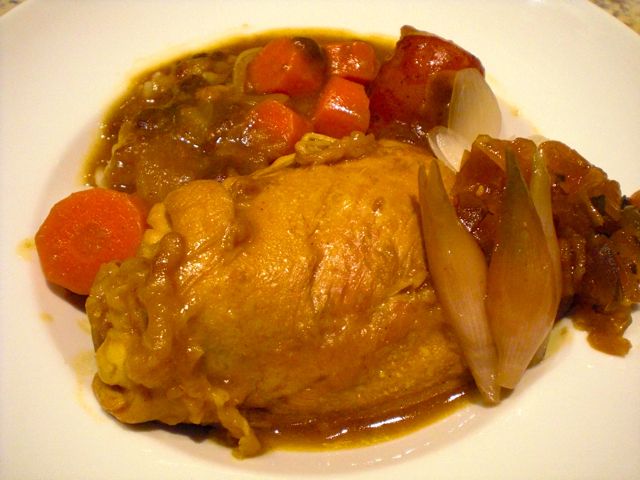
In any case, going back to curry, even when I was living in Japan, some more authentic Indian curry restaurants were opening up. Now, in many cities in Japan, you have many authentic (I suppose) and diverse ethnic curry restaurants. But the Japanese style curry is still popular in Japan and it will not disappear any time soon (I hope). As a sign of the popularity of Japanese curry, commercial Japanese curry roux is even available in a regular American supermarket. I occasionally make my own curry sauce based on brown roux and a Japanese curry powder (supplemented by other spices such as toasted mustard seeds, cinnamon, cumin etc), but the problem is the smell of the spices while being dry roasted linger in the house for several days. So this time, I made this curry using a S&B brand curry roux. My only modification to this Japanese curry is using whole bone-in, skin-less chicken thighs instead of small pieces of meat which is common in Japanese curry. The vegetables to be used include onion, carrot and, of course, potato to be authentic Japanese curry.
Dr. Clark's parting words to the students who came to see him off at a place known as "Hitsujigaoka" 羊ヶ丘 or "Sheep hill" in Sapporo was "Boys, Be ambitious". This became the motto for Hokkaido University as well as general encouragement for young boys in Japan. (The entire phrase was "Boys, Be ambitious like this old man". Thankfully the egotism "like this old man" was left off the Hokkaido University motto). His statue on the campus used to be a major tourist's attraction but is less so now that access is restricted to foot traffic. His statue on the famous Sheep Hill is more easily accessible and more popular. On one of our first trips after our marriage to Hokkaido, I took my bride for a reverent visit to the statue at Sheep Hill. She was significantly underwhelmed. She took one look at the statue with its motto and said "only Boys...really?" She then scanned the pasture with its few obligatory sheep scattered about in keeping with hill's name and dubbed the place "that tourist attraction where they keep a few sheep on leashes." (I sure can digress!)
First, I removed skin and excess fat from the thighs. I dredged them in a mixture of curry powder (again S&B) and AP flour (the proportion is arbitrary but I used 1 tsp of curry powder to 1/4 cup of flour) in a Ziploc bag. I brown the surface of the meat in a large saute pan on high heat with olive oil, turning once for 5 or so minutes per side. I removed the chicken and placed it in a separate stock pot or Dutch oven. I added roughly chopped onion to the saute pan and sauteed for several minutes and de-grazed using a small amount of chicken broth. I added this to the pot with the chicken thighs and added chicken broth (my usual Swanson reduced salt no-fat kind) and water (about half and half to prevent it from being too salty) to cover. I added potatoes (I used small red potatoes with the skin on, eyes removed) and carrot. (The amounts of vegetable and liquid are arbitrary but please refer to the package instructions of the curry roux for the appropriate ratio of the roux and liquid.) I simmered it for 30 minutes with two bay leaves (optional). I dissolved the curry roux and simmered for another 5 minutes.
The classic Japanese condiments to curry are pickled "rakkyou" らっきょう (left) and "fukushinzuke" 福神漬け (right in the back). I had the last of the homemade pickled myouga 茗荷, which was added as well (middle).
Using bone-in whole thighs is easier than cutting up the chicken in small pieces. It also appears to add more flavor to the dish. One of the problems of using the commercial curry roux may be the amount of saturated fat and salt it contains but it tastes really good nonetheless. A good sturdy red wine will be our choice of libation here. We had Worthy 2006 which went well with curry.
Sunday, November 14, 2010
Duck "Nanban" Soba 鴨南蛮
When I made the Japanese-style chicken escabeche, which is called "Nanban" 南蛮 or Southern Barbarian, I mentioned another totally unrelated soba noodle and duck dish called "Kamo Nanban" 鴨南蛮. Since I had leftover roasted duck breast after I served duck breast with orange marmalade sauce one weekend, I decided to make an abbreviated version of "Kamo nanban" on a following weekday evening.

As I mentioned before, Japanese think "duck" and "negi scallion" are the ultimate culinary paring and this dish is usually made of grilled and charred, Japanese or Tokyo scallion or "naga negi" 長葱 in addition to duck meat.
We also enjoyed stewed "Kabocha" squash. As before this one was sold as "Butter cup" squash but I believe this is identical to a Japanese "Kabocha".
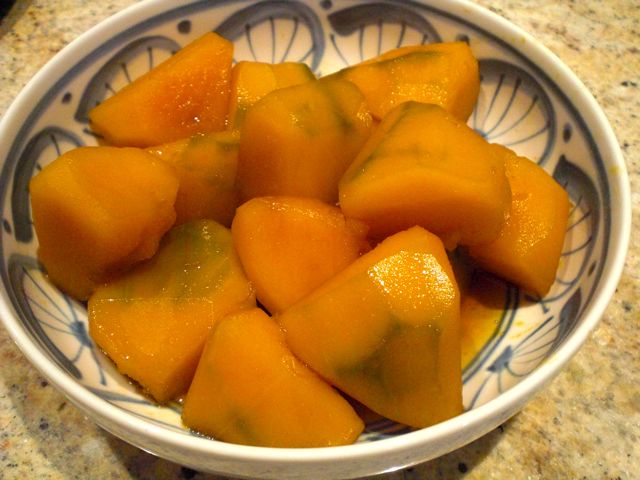
Negi Scallion: Since I did not have a Japanese "Negi" scallion, I used a wedge of onion. I cooked it slowly in a frying pan with a bit of light olive oil, turning over once or twice for 10 minutes or until nice char marks developed on both sides and the onion is cooked.
Broth: I used one "dashi pack (The one I used had kelp and dried bonito, but no dried fish)" in water (about 1.5 cups) and simmered for 5 minutes to make dashi. Any dashi, including instant granulated ones, will do. I added mirin (1tbs) and soy sauce (2 tbs to taste, I could have added more in retrospect). I kept it just barely simmering or hot.
Duck breast: The leftover duck breast had nicely browned skin and was cooked to medium rare. I cut thinly (1/4 inch) and then dusted the pieces with potato starch, katakuriko 片栗粉. I placed each piece in the simmering broth (above) for 20-30 seconds so that the starch cooks into a slightly slippery coating on the surface of the meat. It also very slightly thickens the broth. if I was cooking the duck from scratch, I would cook the skin side only in a frying pan rendering as much fat as possible while making the skin brown following the first step of my usual way of cooking the duck breast. Instead of finishing the duck in the oven, I would slice the meat and cook it in the broth as descried above for a slightly longer time. You can omit the potato starch, if you do not like the slippery texture.
Soba noodle: I just used dried soba and cooked as per the package instruction, washed in running water, drained and placed in the center of an individual serving bowl.
Assembly: In the bowl with soba noodle on the bottom, I added the broth, and arranged the onion and duck meat as seen above. I garnished it with chopped green onion. Just before eating, I sprinkled 7 flavored Japanese red pepper powder 七味唐辛子.
Up until this point, we were enjoying Orin-Swift "The Prisoner" 2009 (Zin and Cab mix). It was certainly a good wine but it is not as good as the prior vintages and we prefer "Papillon" 2007 (Bordeaux blend with predominant Cab) from the same winery. But this dish cries out for sake and we obliged. I should have added a bit more soy sauce to the broth but otherwise it was a very nice dish and indeed went very well with cold sake.
We also enjoyed stewed "Kabocha" squash. As before this one was sold as "Butter cup" squash but I believe this is identical to a Japanese "Kabocha".
Friday, November 12, 2010
Mac and Cheese マカロニチーズ
I think that the quality and types of cheeses are most important. My recipe is nothing unusual. I first make béchamel sauce and add cheeses, combined with cooked elbow macaroni and bake. This recipe is for about 6 oz of macaroni, which makes about 4 small servings. We cooked one box (16 oz) of elbow macaroni and we used about 2/3 for macaroni salad and 1/3 for Mac and cheese.
Macaroni: As per the instruction on the package, cook Macaroni (al dente, since this will be further baked). I season it with salt and pepper in a colander immediately after draining and coat it with a small amount of olive oil. The macaroni alone at this stage should be well seasoned and taste fairly good.
Sauce: I first make béchamel. I finely chop shallot (one medium or 1/2 large), and saute in olive oil (3 tbs) and butter (1/2 tbs) and add flour (3 tbs). Cook flour for 1-2 minutes (do not brown, we are not making brow roux) and add about 2 cups of milk (I used 1%) at once and whisk to resolve and keep stirring until it thickens. Add more milk depending on the consistency of the sauce. I keep this rather loose since the addition of the cheeses makes the sauce thick. I season it with salt, pepper, and freshly grated nutmeg. Using freshly grated nutmeg makes a big difference in taste.
I poured the sauce into the cooked macaroni and mixed in shredded cheddar (1/2 cup, I used aged sharp cheddar). I tasted the mixture and adjusted the seasoning. I apportioned the mixture into 4 small individual ramekins. I grated Parmigiano reggiano cheese on the top. You could use bread crumbs on the top as well, but I did not. I baked it in a 400F (toaster) oven for 7-10 minutes or until the surface browns and the sauce is bubbling.
This was not bad (my wife's opinion was much less reserved but, then again, she may be biased). Nonetheless, to me, the sauce was a bit too grainy and I blame it on the goat cheese. Next time I will have to be more moderate in using it. In any case, this was far better than Kraft's or Wolfgang Puck's mac and cheese. This dish goes well with wines and beer (although we drink beer extremely rarely). I would suggest Izakaya in Japan consider serving this. It may become a big hit.
P.S. We had this later in the week as leftovers reheated in the toaster oven. Strangely enough, the taste and texture were much better and the graininess of the sauce disappeared.
Wednesday, November 10, 2010
Chicken breast cutlet 鶏胸肉のカツレツ
It is a somewhat mundane dish but a nice dish to start. We had this with a red wine but I can not remember which one this was.
Monday, November 8, 2010
Poached egg, smoked salmon with crème fraîche ポーチドエッグとスモークサーモン
This can be a breakfast (for us) on weekends when it strikes our fancy or a mid-night snack after drinking (for younger fellow imbibers). I'm not sure how this got started but my wife came up with this one. It is a cross between bagels, lox and creme cheese (hold the bagel) and a variation of eggs benedict (hold the hollandaise). This variation may be (very) slightly, less deadly than the original because there is no hollandaise sauce and (hopefully) some benefit from the Omega 3 in the salmon.

The poached egg should have a runny egg yolk so that when you cut into it, the yolk makes a wonderful sauce. The combination of all these ingredients work so well together. If you like smoked salmon, you will like this dish.
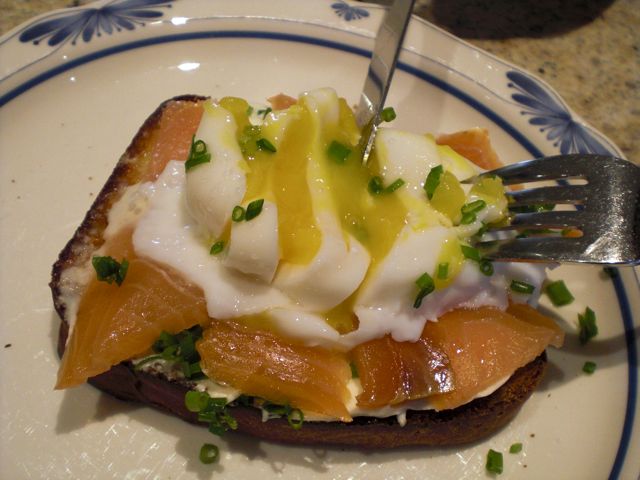
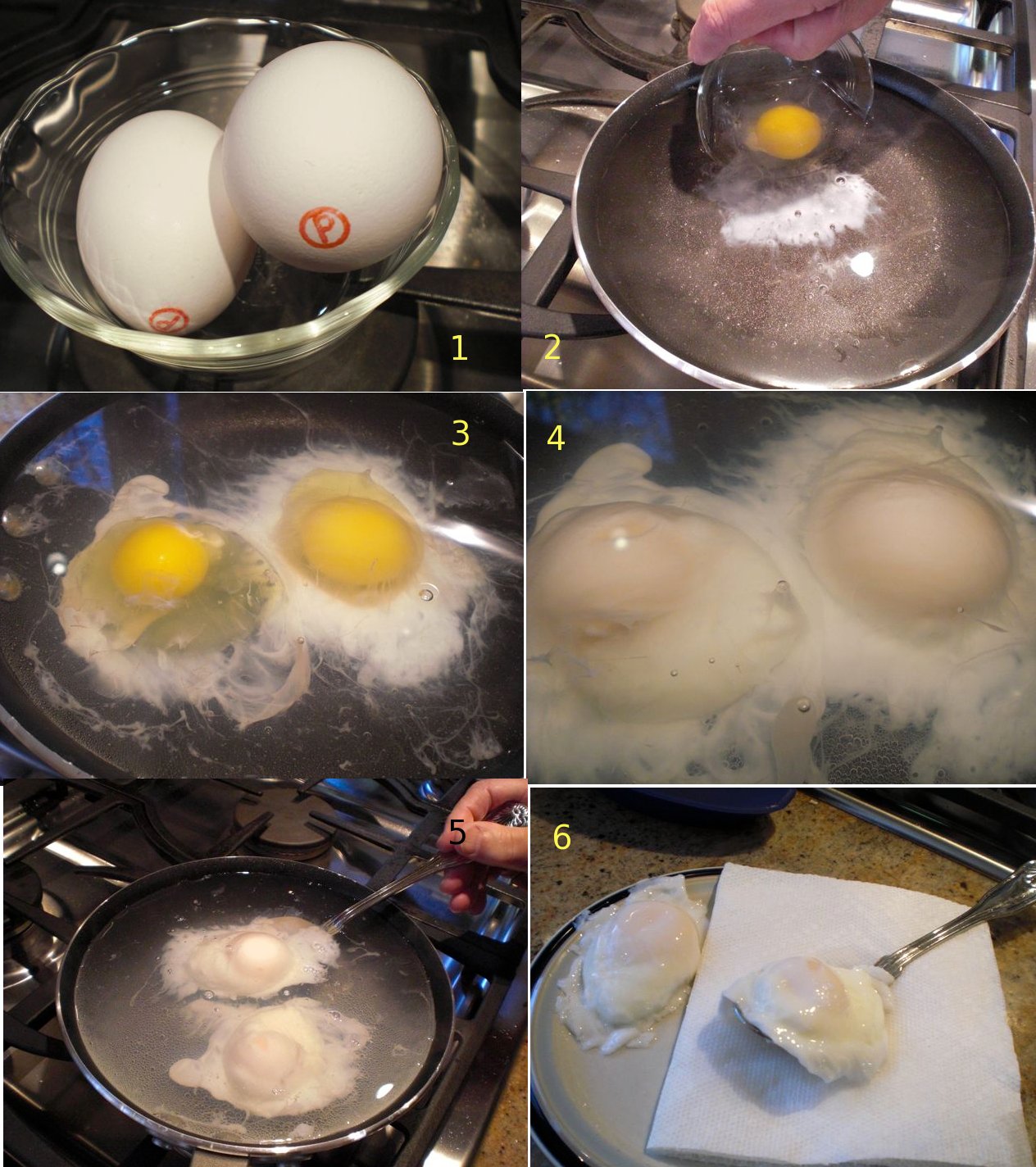 5. Using a perforated (slotted) spoon, gently separate the eggs from the bottom. It should not be difficult if the pan is a good non-stick pan. If you encounter undue difficulty, use a silicon spatula to separate the eggs from the bottom of the pan, (if that happens you may want to throw out the pan and buy a new one).
5. Using a perforated (slotted) spoon, gently separate the eggs from the bottom. It should not be difficult if the pan is a good non-stick pan. If you encounter undue difficulty, use a silicon spatula to separate the eggs from the bottom of the pan, (if that happens you may want to throw out the pan and buy a new one).
If you are into the looks, you could take off thin peripheral shaggy portions of the egg white to make it pretty.
The recipe starts with a base of toasted and buttered English muffin bread (homemade, my wife promised me to post her recipe soon). On top of that goes a generous smear of crème fraîche (if not available, use sour cream or cream cheese). Next comes a sprinkle of chopped chives (my wife puts the chives on at this point so they are held in place by the next layers. Otherwise they just fall off the piece on the way to your mouth. One layer of good cold smoked salmon follows the chives and the whole thing is topped with a poached egg. We sprinkled salt on top of the egg and more chopped chives as garnish. (It doesn't matter if these fall off the chive flavor is locked in the lower layer.)
Since I mentioned several times how easy it is to make poached eggs but never really illustrated the steps, I decided to post some visual aids. We tried many methods including an egg poacher, a classic vinegar water method, Pepin's swirl-water-and-put-an-egg-in-the center-of-the-vortex method (it appears he is not advocating this silly method any longer) but our method always works, no fuss no muss.
1. Use pasteurized eggs (in the U.S., notice a red "P" in a circle).
2. Use a good non-stick frying pan with a high side wall and add enough water so that the eggs can be completely submerged. I also salt the water for subtle seasoning of the eggs (optional) but absolutely no vinegar. (We do not like vinegar tasting eggs). The water should be just barely simmering. Crack an egg into a small ramekin and slide the egg as seen here.
3. Eggs will sink to the bottom.
4. Eggs will stick to the bottom (Do not worry). Poach them until the surface of the yolks are opaque and set but the yolks are still runny (4-5 minutes).
6. Drain the water trapped by the spoon or dripping off the egg by touching the bottom of the perforated spoon to a paper towel and place it on the plate (Do not leave it on the paper towel. It will become very difficult to transfer without breaking the yolk). I usually keep one on the spoon as seen in the picture for easy transfer.
If you are into the looks, you could take off thin peripheral shaggy portions of the egg white to make it pretty.
Saturday, November 6, 2010
Julienned potatoes with spicy cod roe redux ジャガイモの明太子和え 再登場 (Mark's book p24)
We liked the nori taste with tarako and potatoes. Either way (the original or this version), this is an excellent dish. We really like both versions.
Thursday, November 4, 2010
Monkfish medallion sautéed with garlic and olive oil アンコウのニンニクオリーブオイル焼き
After making the monkfish karaage 唐揚げ, I made the remaining monkfish fillet into this dish the next day.
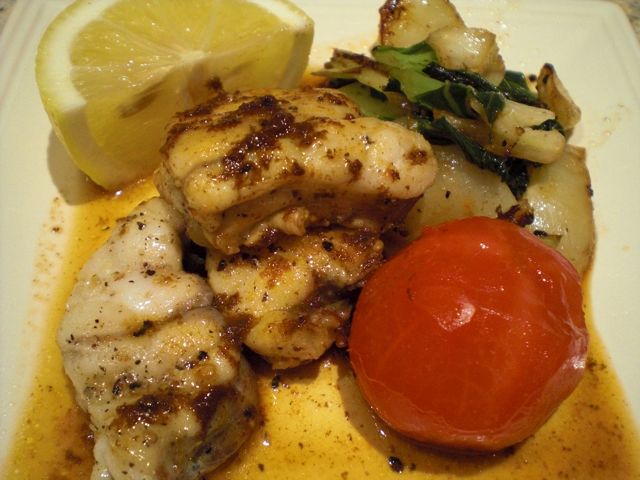
I made medallions of fish a bit less than 1 inch thick. I then marinated them in olive oil, lemon juice and 3-4 fat cloves of crushed garlic for 24 hours. Just before cooking, I removed the excess moisture from the surface of the medallions and lightly seasoned them with salt and pepper. In a frying pan on a medium flame, I added olive oil, and crushed garlic from the marinade and fried it until it became fragrant and slightly brown. I took the garlic out and set aside. I added the medallions of monkfish and cook them for 3-4 minutes and flipped them over. At this point, I added previously blanched Bok Choy which was cut into a bite sized pieces to the center of the pan, moving the medallions to the periphery to make room for the Bok Choy. I then put two thin pats of cold butter on the top of the Bok Choy and cooked it for another 3-4 minutes. The butter will melt very slowly. As the fish was about to finish cooking, I mixed the Bok Choy and butter and added just a small amount (1 tsp) of soy sauce and also add skinned Campari tomatoes to the pan for another minute or so and, at the very last moment, added back the garlic.
This is a sort of fusion dish and almost tastes like lobster tail. The rather assertive garlic flavor goes well with this fish. The tomatoes also exude some juice to form a small amount of sauce/liquid in the bottom of the pan. The flavors of soy sauce, butter, garlic and tomato add to the dish.
Tuesday, November 2, 2010
Chestnut rice 栗ごはん
Chestnuts are such a typical seasonal food item in Japan for deepening autumn. As a kid in Japan, we ate them every fall, usually boiled and it was something I generally liked. We had quite a few mature chestnut trees in our neighborhood. Many half open "Iga" いが or outer prickly shells were on the ground and getting chestnuts from those shells was always tricky for young kids. The trick was getting the nut without being pricked. In North America, because of Chestnut blight, most of the North American Chestnuts trees were wiped out by 1940. Chestnuts, maybe as a result, appear not to be a very popular food item. The vast majority of chestnuts we see here are imported from Europe (see P.S. below). My wife tells me that her childhood memory of chestnuts was the yearly ordeal (usually around Christmas) of roasting them in the shell over an open fire in the fireplace. While they smelled great, they weren't worth the bother. Once she busted into them, they were a major disappointment--dry, chalky, tasteless.

On one of our first trips to Japan as a married couple, we came across a roasted sweet chestnut vendor, "tenshin amaguri" 天津甘栗, under the raised railroad tracks in Shinbashi 新橋 area of Tokyo. The smell wafting from the cart was divine. I suggested we get some and my wife said, "Don't bother" and kept walking. I got them anyway and the smell enticed her to try some. She was astounded at how good they were. She insisted they couldn't be the same thing she ate as a child. Last week I found chestnuts in the shell at our gourmet grocery store. I, again, could not resist and got some chestnuts for a Japanese chestnut rice or "kurigohan" 栗ごはん. Again my wife advised, "Don't bother" and warned me that they would not taste like the ones I was used to.

I again used the earthenware rice cooker called "Kamado san" like I did when I made "Matsutake gohan", I used kelp soaked water and added sake (2 tbs) and salt (1 tsp) to make 400ml of the cooking liquid. I did not use soy sauce to prevent the rice from darkening. I washed and drained the rice (2 Japanese cups or 360ml). I added the rice and the liquid into the cooker, and placed cleaned chestnuts on the top (lower right in the above image). As per the instruction that came with the cooker, I put on the inner lid and then the outer lid. I cooked it on a medium high flame for 14 minutes and then let it stand for 20 minutes.
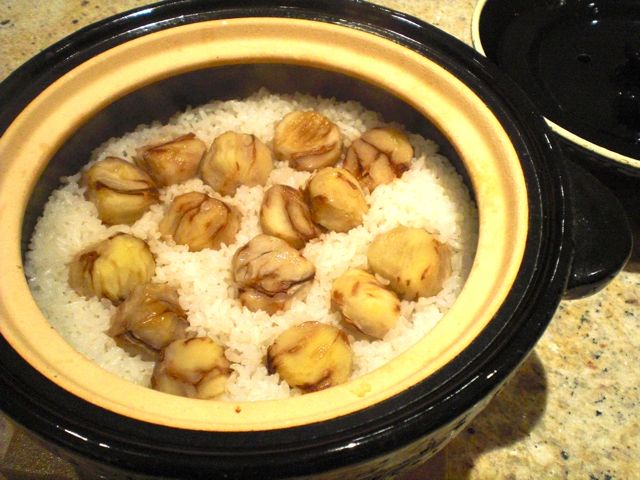
Here is the end product (above). I was a bit disappointed--I "shouldn't have bothered". The chestnuts were dry, chalky and pretty tasteless (as my wife predicted), although they were certainly edible. The rice itself was quite nice. We may try this again with bottled boiled chestnuts from France next time. But at least, I feel like I paid some respect to autumn, which has firmly arrived here.
P.S. After I posted this, an interesting article appeared in Washington post regrading chestnuts including different types and origins of the chestnuts imported here.
I first soaked the chestnuts (15 or so, upper left in the image below) in water for several hours to make it easier to peel the outer hard skin. You could also parboil to make it easier to remove the skin. It is easy to take off the hard skin called "onikawa" 鬼皮 by cutting off the bottom and peeling off the hard skin but the chestnuts are still covered with the bitter-tasting inner skin (upper right). The most labor intensive part is removing the inner skin called "shibukawa" 渋皮 meaning "bitter skin". I just used a small paring knife to remove the inner skin but it is not easy. I put these cleaned chestnuts into water to prevent discoloration (lower left).
P.S. After I posted this, an interesting article appeared in Washington post regrading chestnuts including different types and origins of the chestnuts imported here.
Sunday, October 31, 2010
Flounder simmered in Japanese broth カレイの煮付け
I do not think I ever made this dish before. Probably because I somehow associate this dish with being ill as a kid. This was the first solid food my mother served me when I was recovering from some GI ailment. My mother thought this dish was the most mild flavored, easily digestible and highly nutritious food she could serve to speed recovery. All this is probably true but I can't imagine feeding this to an American kid just getting over a tummy ache.
I bought too much fluke (flounder) which I used in my matsutake dish. I thought about making menier or grilled or fried flounder but I decided to make this dish. One of the reasons I chose this dish is because I had extra kelp broth left over from when I made matsutake rice.
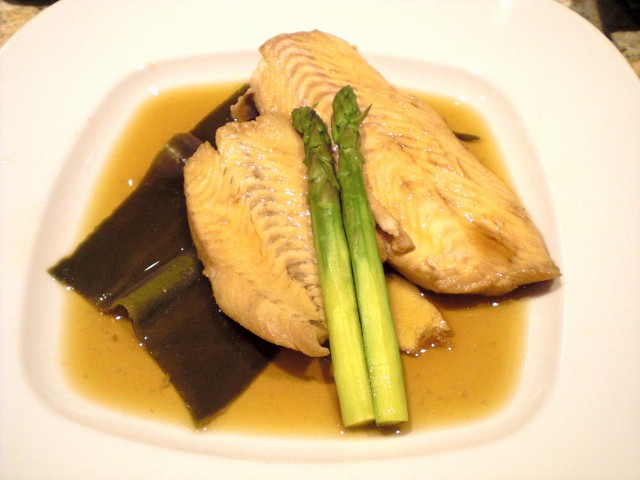
The different Japanese and English names for flatfish are numerous and confusing. I usually associated the Japanese name "Karei" カレイ 鰈 (The left symbol which makes up this kanji letter is "fish魚" and the right symbol is "leaf葉") with sand dabs and "Hirame" 平目 (meaning "flat eye") with flounder or fluke but I am not sure this is a correct association. A classic Japanese recipe calls for small sand dabs or karei for this dish so that the whole fish with skin on is simmered in broth (see image below). The skin adds a slightly slimy texture which, I suppose, the Japanese like but I only had previously skinned and boned fillets of flounder.
Here is a more classic image of "Karei no nituske" カレイの煮付け(http://www.jf-net.ne.jp/kagyoren/image/santi/12-6.jpg)
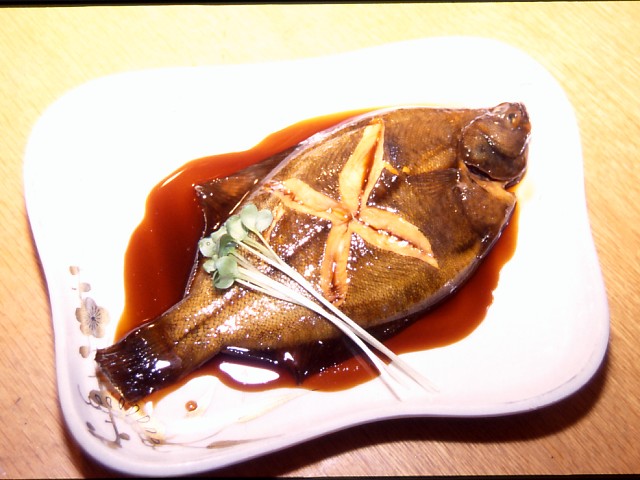
I bought too much fluke (flounder) which I used in my matsutake dish. I thought about making menier or grilled or fried flounder but I decided to make this dish. One of the reasons I chose this dish is because I had extra kelp broth left over from when I made matsutake rice.
Broth: Again, this is typical Japanese seasoning combination. I used kelp dashi, sake, mirin, and soy sauce (2:1:1:1). If you like you could add sugar (up to 1 tbs) to this. You must add enough slices of fresh ginger (3-4 thin slices) to add a good ginger flavor to this dish. I placed the seasoning liquid in a flat wide pan like a sauté pan so that the fillets are in a single layer and covered with the seasoning liquid. I gently simmered it for 10 minutes. Since this was a fillet, I did not bother with "otoshi buta" 落とし蓋 but instead, I covered it with a piece of kelp while the fish was cooking.
I served the fish with the kelp on the bottom (as decoration, just becase I had it) and boiled asparagus. I had to admit, this is not one of my favorites but it has a nice gentle texture and the taste of fresh ginger. Oddly, I am already feeling better.
Here is a more classic image of "Karei no nituske" カレイの煮付け(http://www.jf-net.ne.jp/kagyoren/image/santi/12-6.jpg)
Friday, October 29, 2010
Braised potatoes and green beans 小芋とインゲンの煮物
This is a very homey and simple dish. My mother used to make it often. I made this one evening since my wife washed and dried green beans but did not have a time to make the dish she had in mind and was in the process of putting them away in the refrigerator. I just grabbed a handful of green beans and made this dish.

One of the problems I have is that I do not measure anything especially for this kind of dish The amount of ingredients and seasoning is just a guesstimate. The above picture is the entire amount I made; about 20 green beans and 6-7 baby red potatoes.
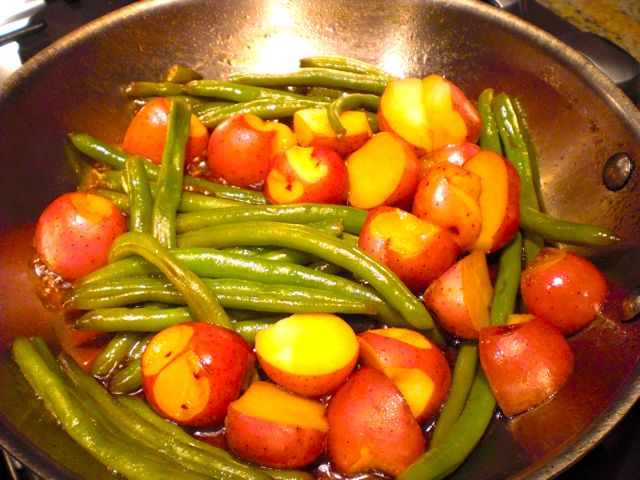
This is a somehow very comforting dish for me since it was one of my mother's repertoire. Classic Japanese seasoning but the fresh taste of green beans comes through. Perfect side for any Japanese meal or you could have it by itself with sake like we did.
I removed the "eyes" of the potatoes and cut them in half or quarters depending on their size. In a large frying pan on a medium flame, I added 1/2 tbs of vegetable oil and a splash of dark roasted sesame oil. When the oil was shimmering, I added the green beans (please make sure they are dry, otherwise it splatters) and the potatoes and sautéed briefly so that all the vegetables are coated with oil. I added 2-3 tbs of mirin and tossed it around. After 1 minute or so I added chicken broth (3-4 tbs, non-fat and reduced sodium Swanson as usual but you can use dashi, sake, or water). I put on a tight fitting lid and turned down the flame to a low simmer. I let it cook for 10 minutes or so and added 1 tbs of soy sauce. I put back the lid and simmered it for another 5-7 minutes. I opened the lid and checked the potatoes to see it they were done (insert a skewer or knife tip). If the potatoes are not done and not much liquid is left, add more water or chicken broth. (In my case, the potatoes were done). The liquid should be reduced quite a bit at this point (Picture below). I added a half tbs more soy sauce (to give a fresh soy sauce flavor) and tossed it around and let the liquid evaporate almost completely (another 1 to 2 minutes).
Wednesday, October 27, 2010
Tuna "namerou" tartar 鮪のなめろう
I have done posts about frozen yellow-fin tuna sashimi block or "saku" 冊 previously several times. Although it is by no means quality tuna sashimi, it is very convenient to have in your freezer and affordable. My quest to make this frozen tuna palatable continues. This evening, I made three different dishes--one of them I attempted for the first time.
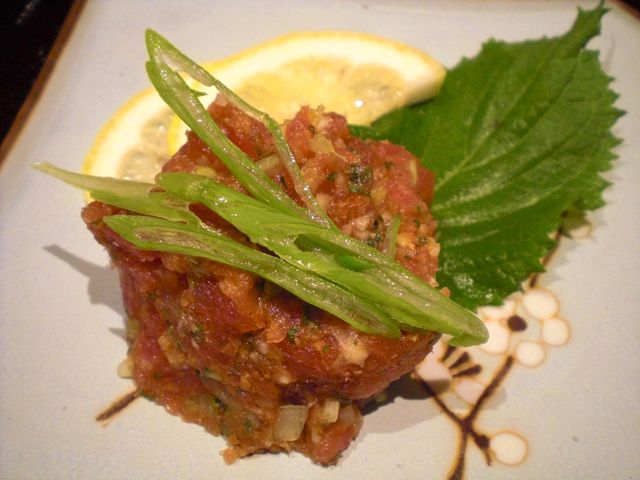

This is variation of "zuke" 漬け. Last time I made it, it was very good but, for me, it was a bit too salty, so I made some modifications to make it more like slightly flavored sashimi than a classic "zuke" preparation. I used the same type of marinade but increased the amount of sake and mirin (sake, mirin, regular dark soy sauce and usukuchi syouyu in 2:2:1:1 ratio). I also added ginger juice (from freshly grated ginger root), and coarsely ground roasted white sesame as before. I also did a "shimofuri" 霜降り process and then marinated it for 2 hours in the refrigerator. This is not quite "zuke" and the consistency of the tuna did not change too much to the point of "sliminess" like in a classic "zuke" preparation. The marinade did impart nice flavors and the consistency of the tuna was quite good. I sort of like this preparation. So far, two solid hits for me tonight--one more to follow, bases loaded. Actually, at this point, probably more than just "bases" are loaded. These two dishes are so perfect with sake we may be "enjoying" ourselves too much at this point.

This is called "namerou" なめろう. It is a type of "tataki" たたき or Japanese style tartar type preparation. I am not sure of the origin of the name but "nameru" なめる means "to lick". This dish was said to be made by a fisherman on the boat, simialr to the origin of "okizuke" 沖漬け. The fish used in this dish is usually a blue-white shiny skinned fish, "hikarimono" ひかりもの, such as mackerel. Tuna is not commonly used but I made this with the frozen tuna.
I used about 1/3 saku since I made three different dishes shown here. I first roughly chopped the tuna into small cubes, sliced scallion, minced perilla and fresh ginger (amounts all arbitrary). I added half a tsp of red miso paste to start. I minced (or "tataku", meaning to bang or hit with a knife blade) all these together until it became sticky and well mixed but still retained some shape. I tasted it and added a little more miso to finish. If this becomes too stiff, you could add a small amount of sake to make it the right consistency, which I did not need to do. This was a great success! Because of the many flavors especially the miso and the nice consistency, it was perfect to nibble while sipping cold sake. If you were not told, you would not be able to tell that this was made of frozen yellow-fin tuna.
The third tuna dish is our usual stand-by and is nothing new; just classic "yamakake" やまかけ.
We think, even for frozen saku of yellow-fin tuna, these three dishes I made tonight were quite good (I know my standards may have fallen substantially compared to those of Japanese food connoisseurs out there, especially a few in Tokyo).
Monday, October 25, 2010
Brie and Fuji Apple quesadilla ブリィチーズとリンゴのケサディア
This is a very interesting quesadilla. I bet you will not get this in Mexico but it is perfect with wine. We saw this in "Cooking Light" (paper copy) and both my wife and I independently thought it was interesting. Although the recipe came form "Cooking Light", by no means, is this dish "light".
I spread a thin layer of Dijon mustard (Grey Poupon) on one side of both tortillas. In a small (8 inch) frying pan on low flame, I add 1 tsp of olive oil and placed the first tortilla with the mustard side up and placed slices of brie on the tortilla. After the cheese started melting, I placed thinly sliced Fuji apple on the cheese to cover the surface (I peeled and cored the apple before slicing) and a handful of arugula on the top. I sprinkled freshly cracked black pepper over it. I then placed the other tortilla with the mustard side down. I pressed gently with a spatula. After few minutes, I flipped it to brown the other side and cook it for 2-3 more minutes.
As you can see in the above image, melted brie started oozing out as I tried to cut it. The unique combination of goat milk brie, mustard, black pepper, apple (still crispy, sweet and sour) and slightly peppery arugula, all works together. The goat milk brie had a very pleasant somewhat "gamey" flavor. This was a very nice Franco-Mex (?) hors d'oeuvre indeed, which goes particularly well with wine. We had this with red wine but any white, particularly something like Riesling will also do.
Sunday, October 24, 2010
Pork cutlet bowl カツ丼
This looks like the classic lidded Japanese bowl you may see in "Taishu shokudo" 大衆食堂、which is the Japanese equivalent of American diners. I do not remember when I got this bowl but it must have been in California. I have not used this bowl for a long time for some reason. This dish, Katsu-don カツ丼, is a classic dish being served in Japanese eateries and this bowl is perfect for it. Since we had already made pork fillet cutlets, I made this classic dish from the leftovers and frozen rice. Of course, you could make this from just fried tonkatsu and freshly cooked rice, which would be much better.
There are two distinctive styles in "Katsudon". One type is with soy sauce based broth and beaten egg anchoring everthing together called "Tamago-toji katsudon" 卵とじカツどん, which is, by far, the most popular style and is usually referred as simply "Katsudon". Another (more regional and less popular) kind is tonkatsu dipped in semi-Western style tonkatsu "sauce" with shredded raw cabbage placed on the top of rice, which is called "sauce Katsudon" ソースカツどん. I am from the area of Japan where the former style is the only type of Katsudon available. I personally never had a "sauce" Katsudon but I do not think I am missing much (I can easily image how that would taste).
Here is the view with the lid off, served with beer marinated daikon. Perfect dish to make quickly on a weekday evening. I could have worked on the presentation, though.
To make this dish, you could use the special pan shown below (also perfect for Oyako-don 親 子丼) but I do not have one. Any small (8 inch) frying pan with a fitting lid will also work. You have to use one pan for making one serving. So, in our case, I use two 8 inch frying pans.
Broth/sauce: This is a typical dashi, soy sauce, mirin combination. How much and how strong the broth should be depends on personal preferences. Japanese diners tend to go with a strong broth and a small amount. My wife likes enough broth to moisten the rice adequately. I favor less broth but a bit stronger taste. For this evening, my broth is a compromise. For two servings, it iconsists of dashi (1/3 cup, instant granulated dashi dissolved in hot water), mirin (1 tbs), and soy sauce (1 tbs) but you have to taste and decide how sweet and how strong you would like the broth to be. You could also add sugar, if you like it sweet. I tasted and adjusted further (a bit more soy sauce). I seasoned it more severely than soup you will drink but not as strong as a dipping sauce.You could use any type of tonkatsu. I used "hirekatsu" ヒレカツ or fried fillet of pork.
I arranged the ingredients except for the snow peas in a small frying pan, which makes one serving. I used one medallion of pork per serving for us but I suggest two for most people; sliced in 1/3 inch (or about 1 cm) thick. For vegetables, I used fresh shiitake mushroom (one medium, stem removed but not sliced, with a decorative cut but you can not see it well in the picture), onion (1/4 medium, halved and thinly sliced) and snow peas (2 or more). I add the broth above (1/6 cup or half of what I made). Put a tight lid on the pan and cook for 4-5 minutes on a low flame. I add beaten egg (1 large) and the snow peas and cook another two minutes or so with a lid on. I take the pan off the heat when the egg is just barely congealed in the center.
I place the cooked rice (in our case, microwaved froze leftover rice) in the bottom of the bowl and slide the topping onto the rice with all the remaining broth (The broth reduces a bit. The special pan in the picture comes in handy if you have one). Put the lid on the bowl and let it stand for a one minute or two. If you like the eggs to be a bit runny skip this last step. If you do, please use pasteurized shell eggs). If you have already made rice and tonkatsu, this is a very quick weekday evening meal. Everything tasted pretty good except my wife wanted more broth.
Saturday, October 23, 2010
Japanese Breakfast 日本風朝ご飯
Hangover or "futsuka-yoi" 二日酔い is sometimes an inevitable by-product of the izakaya scene. In my bar hopping days in Japan, hangovers were unavoidable. There are many folk remedies for hangover but their effectiveness is dubious. One such remedy recommended by fellow imbibers while I was living in Japan, was the administration of tomato juice or miso soup--but this never worked for me. Of course, "hair of the dog" or "mukaezake" 迎え酒 (meaning welcoming sake) may be the ultimate cure but it may set you up for the next day's hangover and a vicious cycle may ensue. "Moderation" (what's that) and "hydration" probably are the best way to prevent hangovers.

This example consists of grilled aburaage 焼き油揚げ (top left in the picture below, a bit over done), stewed potatoes and green beans (top right), grilled shishamo 焼きシシャモ (middle left), asazuke 浅漬け (middle right), Perila seedpod tsukudani (bottom left) and miso soup with tofu, wakame sea weed, and aburaage (bottom right).
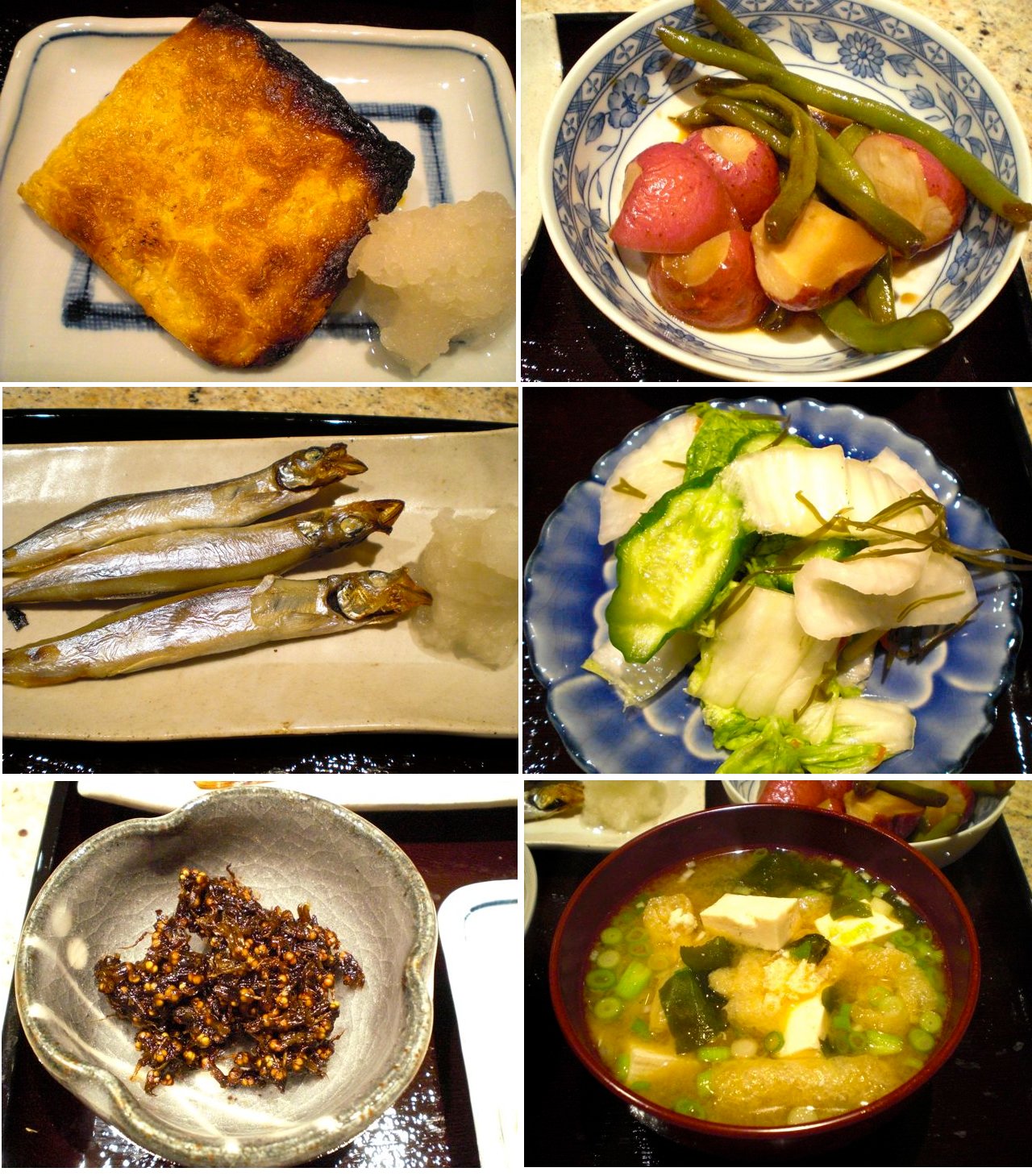
Other common items include seasoned dried nori (味付け海苔), raw eggs (生卵), natto (納豆), Japanese omelet (卵焼き), and any kind of condiments such as tsukudani (佃煮) of small fish, kelp, and nori.
 Next to all the usual Japanese breakfast items sat an egg in a small bowl just like the one shown in the picture. While I knew immediately what it was and what it was for, my wife automatically assumed it was a hard boiled egg, something often served in an American breakfast or at Japanese coffee houses. As she was getting ready to smack the egg hard on the table to crack the shell and eat it, something caused her to stay her hand. And a good thing too. Imagine how embarrassing it would have been to deliberately smash a raw egg onto the table while all the other guests, who were Japanese, were managing to get their raw egg onto the rice. How surprised the other guests would have been! It didn't occur to her for even a second that the egg could possibly be raw! Nobody serves a raw egg in the shell for breakfast in the United States (not even our household) !! But she now knows that, in Japan, they do.
Next to all the usual Japanese breakfast items sat an egg in a small bowl just like the one shown in the picture. While I knew immediately what it was and what it was for, my wife automatically assumed it was a hard boiled egg, something often served in an American breakfast or at Japanese coffee houses. As she was getting ready to smack the egg hard on the table to crack the shell and eat it, something caused her to stay her hand. And a good thing too. Imagine how embarrassing it would have been to deliberately smash a raw egg onto the table while all the other guests, who were Japanese, were managing to get their raw egg onto the rice. How surprised the other guests would have been! It didn't occur to her for even a second that the egg could possibly be raw! Nobody serves a raw egg in the shell for breakfast in the United States (not even our household) !! But she now knows that, in Japan, they do.
In any case, you may want to try a traditional breakfast to combat hangovers after having too much fun in Izakayas the night before. Here is my Japanese breakfast but I did not have a hangover and I ate it as supper (Please do not ask why because I don't know why. I had all the ingredients and it just struck my fancy). If you have a hangover, you will feel better after eating this.
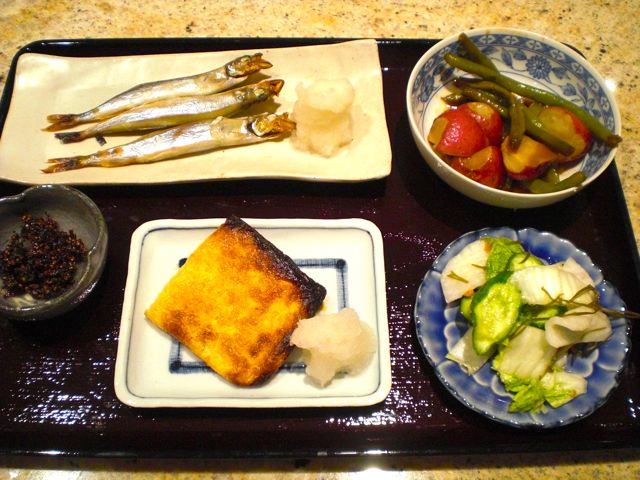
Of course, you need rice and miso soup with any Japanese breakfast.
I am not sure how you feel about eating raw egg over hot rice called "Tamago kake gohan" 卵掛けご飯 (This subject actually appears in Wikipedia--truly amazing!) with a bit of soy sauce (all mixed well), but this is a very popular way to enjoy rice and egg especially in the morning. There is strong following for this dish in Japan with restaurants specializing in it and even a special soy sauce to use on it. (the link is in Japanese).
Several years ago, we stayed at Kinkazan Shrine/Island 金華山 overnight. Why I decided to visit and stay there is a long story. I think I was expecting to have an experience similar to the lovely time we had at a Buddhist temple in Koyasan 高 野山 a few years earlier. Suffice it to say that was not the case. Just a quick hint; the men's showers had only cold water. Breakfast was served after the morning prayer ceremony (participation in the ceremony was mandatory for all guests--something we didn't know before we arrived). The ceremony occurred at 5:30 AM with 50 or so other fellow worshipers. When we say participate I mean literally. The guests are expected to run part of the ceremony. Luckily I was provided with a crib-sheet of instructions to be learned hastily before going to the main alter in front of all those people to "perform". The priestess conducting the ceremony announced our family name and stated that, as devoted worshipers, we came all the way from Washington, DC. Since I am Japanese (at least from outward appearance), I was expected to sit on the hard floor with legs folded (pure agony) but my wife was provided with a folding stool. In my agony, I didn't think that was quite fair. After the ceremony, all 50 guests were herded into another big room where long bench tables were set with a traditional Japanese breakfast.
Friday, October 22, 2010
Sauteed nagaimo 焼き長いも
I have posted quite a few dishes of nagaimo 長芋. You can make so many variations, either cooked or raw, but this grilled nagaimo with black pepper and salt has been featured not once but twice by the expert expats Izakaya connoisseurs and I decided to make my version. Since this was a weeknight, I did not charcoal grill the nagaimo but pan fried it.
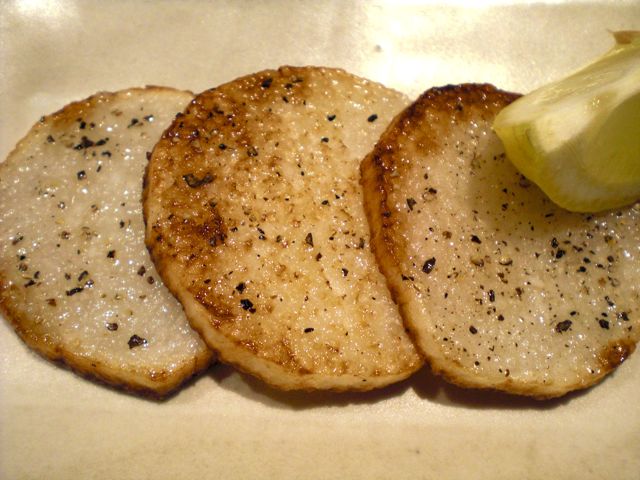
This dish is simple to make. Since I do not like the skin I removed it but you could keep the skin on. I sliced it into rather thin (1/4 inch) disks but this could be a bit thicker. I blotted any moisture from the surface using a paper towel. I added light olive oil (1 tbs) to a hot frying pan on medium-high flame and browned one side rather well (bottom side) for 2 minutes. I flipped it over and fried for 1 more minute. I flipped it over again and sprinkled salt and freshly cracked black pepper. You could use different seasoning such as Japanese 7 flavored red pepper 七味唐辛子, sansho 山椒, or even cumin or curry powder if you like.

We had this as an opening dish with leftover yakitori drumettes reheated in a toaster oven as seen above. The nagaimo has a nice mild crunchy crust and becomes very sweet (some starch must convert to sugar). It is really satisfying and the salt and pepper make this dish. Nagaimo can be simmered in broth as well but I never posted it. Maybe that will be my next post on nagaimo.
Wednesday, October 20, 2010
Grilled Baby Octopus and grilled smashed potatoes 子鮹のグリルと焼き潰しジャガイモ
I don't think I've ever seen uncooked baby octopuses in a regular grocery store. Last time we went to the market to get pasteurized eggs, to our surprise, they had fresh baby octopuses. It was also very cheap (less than $5 per pound and I could not resist getting some). I decided to marinade them in both Western and Japanese styles and just grill them on a charcoal fire.
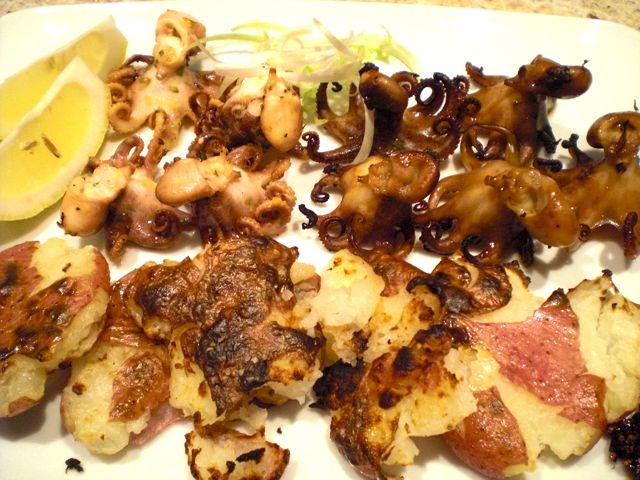
Western style Marinade: Lemon juice (from one medium lemon), lemon zest (from one lemon before squeezing its juice using a micrograter), olive oil (3-4 tbs), salt and pepper. I also added fresh thyme (finely chopped) from our herb garden.

Since we made perilla seedpod Tsukudani 紫蘇の実の佃煮, we tried it on the potatoes. it is much better than just salt. It has very interesting taste, sweet and saltiness and popping texture. We also made our usual grilled rice balls. These food all went very well with cold sake and we stayed until dark on our back deck.
In the picture below, the left four are Western style and the right 5 are Japanese style in the back row (This is the first batch that we grilled, we had much more). Aren't they cute? The front row is smashed and grilled potatoes. I think this definitely qualifies for Izakaya food.
Japanese style marinade: Sake, Mirin, and soy sauce (1:1:2) with several slices of fresh ginger.
I marinated the octopuses for several hours in the refrigerator. I drained the marinade and simply grilled them for 2-3 minutes turning frequently (below, left). As per my wife's idea (she got the idea from one of the issues of Cook Illustrated), she microwaved baby red potatoes, then coated them with oil and smash them flat. We then grilled both sides (below, right).
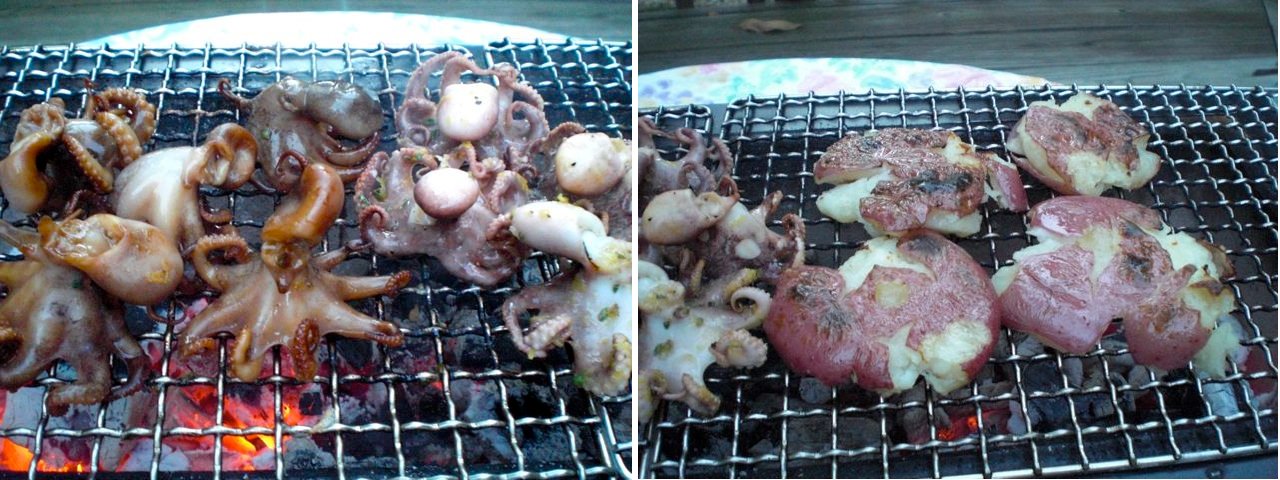
Both styles had lots of flavor, especially the Western version had nice lemony and thyme flavors. Only problem was that both were a bit chewy. For most Japanese, this degree of chewiness is Ok but not for most Westerners including my wife. I ended up cutting them into small pieces.
Our neighbor's dog showed up and hung around despite her owner's calling. She was not about to leave our barbecue. She may get in trouble if this continues.
Monday, October 18, 2010
Artichoke, acorn squash and rack of lamb アティチョーク、エイコーンスクワシュ, 子羊肉
This is certainly not Izakaya food. But I thought, just in case there are some Japanese readers out there, acorn squash and artichokes may be a bit unusual for them. Artichoke is a very strange vegetable (if it is a vegetable). It is the immature flower bud of a giant thistle. Whoever (must have been Europeans) decided this could be eaten, must have been very hungry. In terms of its strangeness and the fact that it is a flower bud, it is on par with myouga 茗荷. I didn't cook artichokes myself until I moved to California from the east coast many, many moons ago. We fondly remember driving through Half-moon Bay on the California coast, one of the major artichoke producing regions of the United States. We often stopped at one of the many road side stands to buy fresh artichokes just harvested from the fields that extended either side of the road. After moving back to the east, the artichokes we see at the market are usually pitiful and we only rarely buy them. Last weekend, I found some reasonably good looking artichokes and I could not resist buying them, but I did not have a chance to prepare them right away.
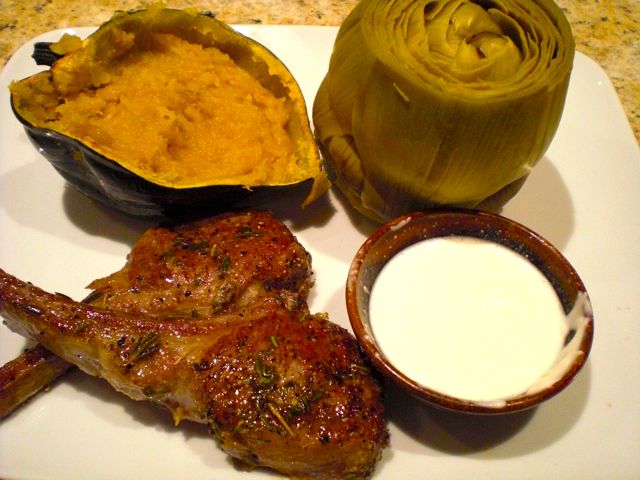
My wife came to the rescue and she prepared the artichokes along with acorn squash the following Friday. I only had to cook the rack of lamb that went along with them for dinner.
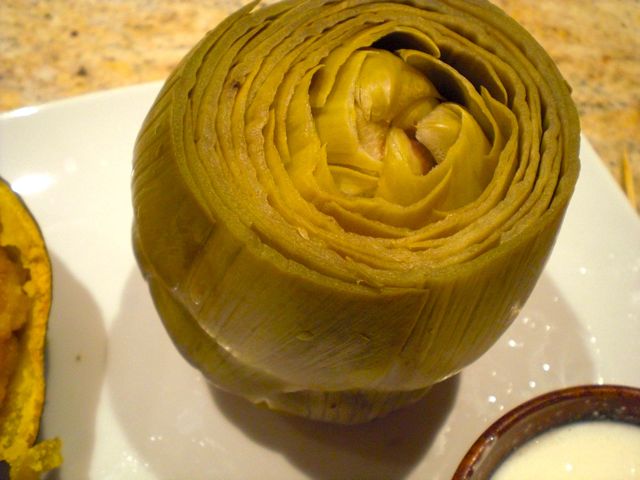
Artichokes: There are many ways to cook artichokes (which also depend on the size of the artichokes). The most classic old fashioned way for regular size artichokes is what we did this evening. How to clean and prepare artichokes is readily available elsewhere. My wife steamed them for 45 minutes in water to which lemon juice, onion, black pepper corns, bay leaf and olive oil had been added. The picture above shows the cooked artichoke served on the plate. What it doesn't show are the many outer petals that were already eaten in transit between pot and plate (It went swimmingly well with a sip of the red wine we were having).

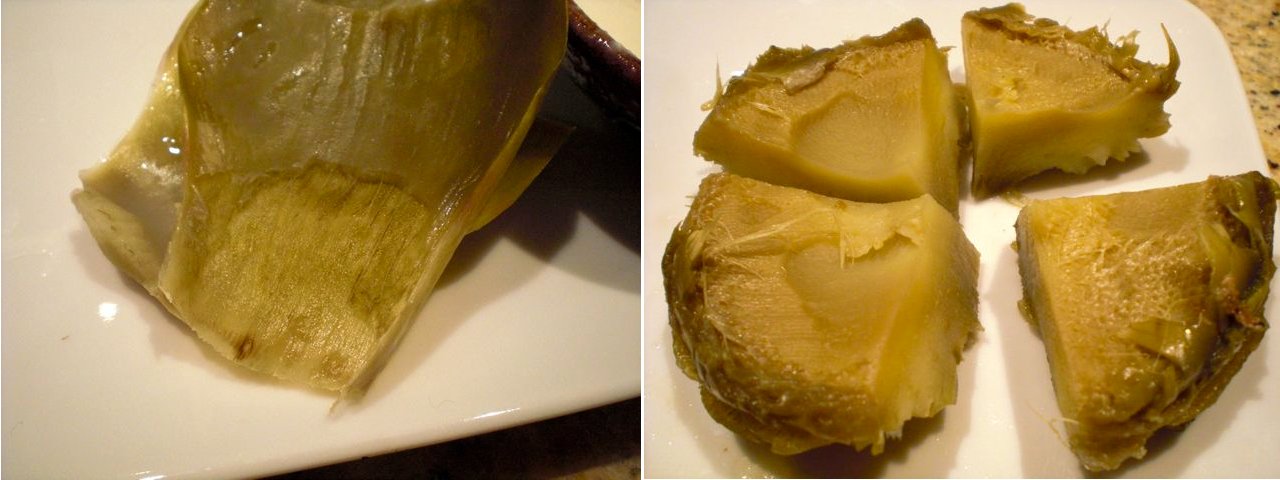 To eat, remove a petal, the edible portion is attached only to the bottom inside of the petal (above image, upper left), dip it in a whatever dip you like (the above image, upper right, is mayonnaise with lemon juice, but you could use melted butter as well) and using your front teeth, scrape off the edible portion (above image, lower left). When you get into the more immature inner petals, not much edible portion is attached. You then remove all the petals exposing the "chokes" (which, I suppose, eventually become the fluffy cottony stuff attached to the seeds to be carried by the wind). As the name implies, you do not want to put these chokes into your mouth. They are not named "chokes" for no reason. The name describes how you will feel if you attempt to eat it--choked. You must carefully remove all the chokes using a knife or spoon or both. You end up with the heart of the artichoke (the above image lower right, this one is already quartered). Actually, this is the meatiest and the best part of the plant. This is what the previous work was all about. The taste of artichokes is difficult to describe. We like it very much but you would have to taste it and decide for yourself.
To eat, remove a petal, the edible portion is attached only to the bottom inside of the petal (above image, upper left), dip it in a whatever dip you like (the above image, upper right, is mayonnaise with lemon juice, but you could use melted butter as well) and using your front teeth, scrape off the edible portion (above image, lower left). When you get into the more immature inner petals, not much edible portion is attached. You then remove all the petals exposing the "chokes" (which, I suppose, eventually become the fluffy cottony stuff attached to the seeds to be carried by the wind). As the name implies, you do not want to put these chokes into your mouth. They are not named "chokes" for no reason. The name describes how you will feel if you attempt to eat it--choked. You must carefully remove all the chokes using a knife or spoon or both. You end up with the heart of the artichoke (the above image lower right, this one is already quartered). Actually, this is the meatiest and the best part of the plant. This is what the previous work was all about. The taste of artichokes is difficult to describe. We like it very much but you would have to taste it and decide for yourself.
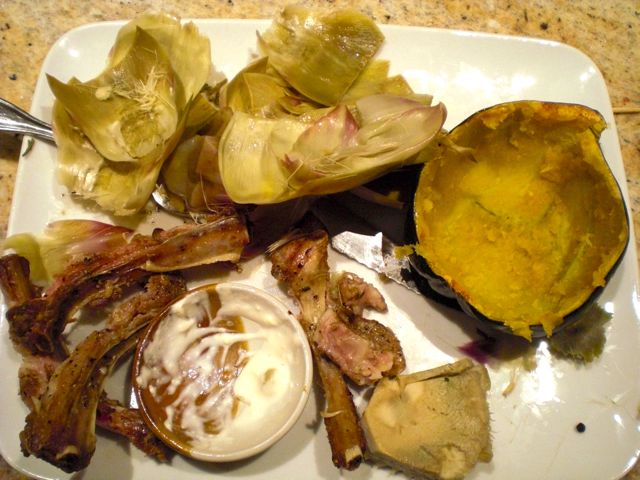
 The wine we had this evening was Benessere Vineyards Napa Valley Phenomenon 2005. This is a California red blend Super Tuscan style and made of Cab Sauv (47%), Sangiovese (27%), Merlot (14%) and syrah (12%), all from St. Helena estate-grown fruits. It is not like classic Napa cab with strong vanilla and chocolate but has a more subtle but complex taste. The tannin is now nicely matured giving a nice backbone to this California Super Tuscan. We like this wine very much. It went so well withthe lamb and artichokes. Perfect for tonight dinner.
The wine we had this evening was Benessere Vineyards Napa Valley Phenomenon 2005. This is a California red blend Super Tuscan style and made of Cab Sauv (47%), Sangiovese (27%), Merlot (14%) and syrah (12%), all from St. Helena estate-grown fruits. It is not like classic Napa cab with strong vanilla and chocolate but has a more subtle but complex taste. The tannin is now nicely matured giving a nice backbone to this California Super Tuscan. We like this wine very much. It went so well withthe lamb and artichokes. Perfect for tonight dinner.
Acorn squash: It is a very popular fall vegetable and my wife cooked it in the traditional American way but seasoned it with a Japanese touch. She cut the squash in half and removed the guts (seeds and inner membranes). She washed it under running water (leaving some water inside). The water puddles under the squash and steams it as it bakes. She then placed them on a flat cooking sheet with the cut-side down. The squash baked in a 350F oven for 45 minutes. She scraped all the meat out of the shells and put it in a bowl. She added butter, honey, and soy sauce (in lieu of salt), mixed well and then stuffed it back into the half shells. This tastes somewhat like mashed sweet potatoes but different. It has a mildly sweet taste yet is savory at the same time. This was a perfect side for the lamb (or more like, the lamb is perfect side for the squash).
Rack of lamb: This was seasoned with salt, pepper, and fresh rosemary. identically seasoned as ones in my previous post but I did not marinate and, instead of an electric grill, I browned it in a frying pan and finished it in an oven (350F 5-8 minutes).
Between the artichoke, squash, and lamb we noticed that this meal resulted in an unusually large amount of debris on the plate by the time we were finished. Doesn't this look the epitome of a good feast thoroughly enjoyed? In case you were wondering, it was.
Saturday, October 16, 2010
Perilla seedpod Tsukudani 紫蘇の実の佃煮
Aojiso 青じそ or green perilla is nice to have in your garden, especially if you are making any Japanese dishes as an ingredient as well as a garnish.The only problem is that this plant is like mint and is very prolific. It will reseed and take over the entire garden if you are not careful. When they start blossoming and making seeds, it is one of the signs of autumn for us. As you can see below, our small raised herb garden is dominated by perilla now with its flowers and seedpods.
I just poured the seasoning liquid of sake, mirin, and soy sauce (1:1:1) just to barely cover the seed pods and add the meat of two umeboshi 梅干し (pickled plum) cut up and also added their stones. I also added rice vinegar (2 tsp) at the very end. I am not sure how much of the seedpods I had to begin with but probably 3 cups or so. After 20-30 minutes with the lid slightly askew to encourage reduction, the liquid almost all evaporated and the pods become brown with the seeds visible (image below).
Subscribe to:
Posts (Atom)





